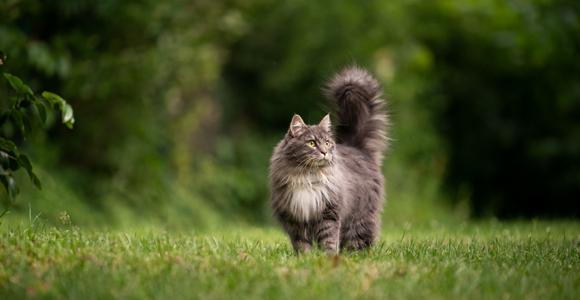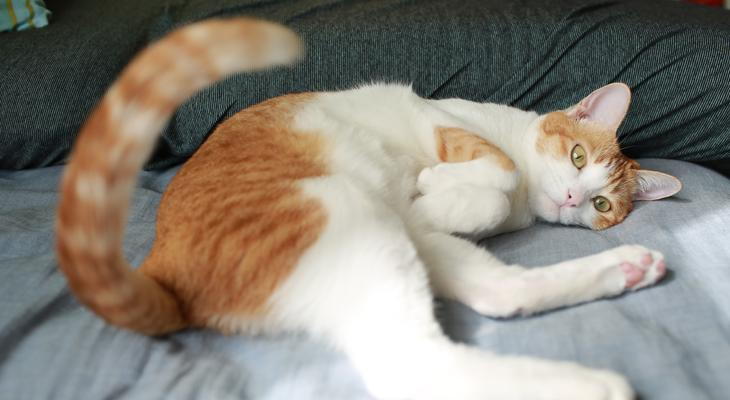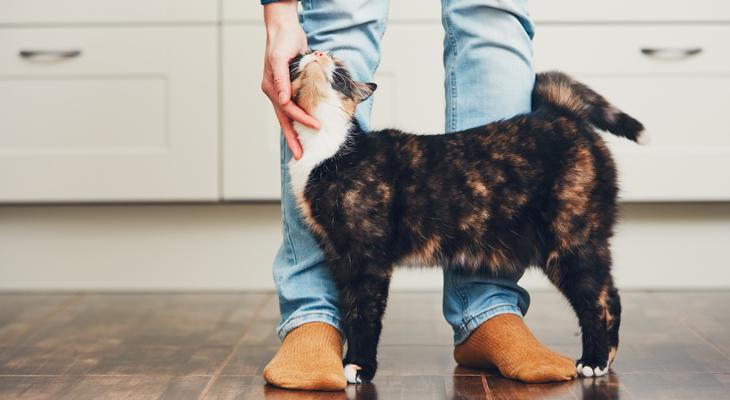Location

Your cat has ways of communicating with you, such as through purrs and meows. Your cat might have no problem biting or growling when they come in contact with another animal they are not fond of or may even do this to people who he or she does not like. However, felines have another way to speak to you -- through their tails. So, what is that tail saying?
Tail Movement
You can tell a lot about your pet's mood by the way he or she moves it. Let’s dive into the different movements and what they indicate about your pet’s emotions.
Loose Wag
If your cat is loosely wagging its tail from side to side, this is a sign that he or she is focusing. It could also be a sign of being playful, or your cat is bored. You might notice this type of motion when your cat is stalking or getting ready to pounce. Interestingly enough, some cats will move their tails in this manner when they're in a deep sleep and are dreaming.
Quick Flicks
Quick flicks are a warning either to a human or another animal. It's a sign your cat is agitated. If your cat continues to be provoked, it's possible it will become aggressive. Take note of the speed of the flicking. When the movement becomes stronger or quicker, the cat is becoming angrier.
Thumping

You may notice your furry friend thumping his or her tail on the ground. This is a tale-tell or "tail-tell" sign, your cat is angry, agitated, or irritated. The speed of the thumping determines the degree of emotion. As your pet becomes more annoyed or angry, the tail thrashing will get harder.
None-Moving Tail
If your cat's tail isn't moving, you want to assess the position for more insight as to how your feline feels at the moment.
Tail Slapping
Sometimes, your feline will slap you with his or her tail. When this happens, your pet is being playful and showing affection.
Tail Position
Your cat's tail position says a great deal about how he or she feels as well.
Tail Tucked Around Its Body
Your feline may tuck its tail around or underneath itself. Your cat is frightened at this point. You might also notice your cat putting its head down or crouching. The purpose of this is to make itself smaller, so predators will not be able to pinpoint its position.
Sometimes, this is also a tail position your cat will use to indicate he or she is hurt. Your cat may curl its tail like this as he or she sleeps. Basically, it's a "Do Not Disturb" signal and indicates your feline wants alone time right now.
Wrapping Tail Around You or Another Pet

This position is one you want to see. Your pet is letting you or the other pet know that he or she loves you or them. It's a sign of affection, and it shows your pet is calm and at peace.
Think about you snuggling with another human. You put your arm around them to feel close, and this is what your cat is doing with this behavior.
Question Mark Tail
If you notice your cat's tail is curled at the end and looks slightly like a question mark, they aren't trying to ask you something. This position could mean your cat is doubtful or playful. To figure out which it is, you should wait for a few moments and continue to assess your pet's behavior. Your cat may begin to play. On the other hand, it could mean your cat is in a stressful situation.
Tail Sticking Straight Up
Sometimes, a cat's tail will stick straight up. This position means your pet is content and feeling confident. Your cat feels there is no danger. Cats may do this in the presence of you or another animal.
If your feline is particularly happy, it may twitch the end of its tail only.
Puffed Out Tail
A puffed-out tail is a sign of danger. Your pet feels threatened and is trying to look more fierce to ward off the threat. It's a common tail position when your pet meets another new animal.
With this tail position, you might also notice your cat will pin his or her ears back, which is a natural instinct to protect them from biting or clawing during a fight. Your cat's pupils will often dilate when this happens.
Downward Facing
A low or downward-facing tail can mean aggression. However, breeds such as Persians will hold their tails in this position for no reason.
Listening to Your Cat's Tail Language
While it's beneficial to know how your cat speaks to you with its tail, you also need to adjust your behaviors in some cases to calm your cat or ease its fears.
When you notice your cat is focusing, let him or her focus. If it's on a toy, start playing along.
If your cat is displaying signals that it is discontent, it's best to stop the behavior you're partaking in or leave your feline alone for the moment. If your cat is letting you know that it feels anxiety or stress, try to remain calm and remove it from the situation.
Anytime your pet is showing aggression, it's a time to step back if it's toward you, a family member, or a guest. If it's toward another animal that he or she is face to face with, you may need to remove the other animal. If the pet isn't directly near your cat, you may be able to pet them until he or she calms down.
During sleep time, if your pet is letting you know he or she needs time alone, you should give that time to your pet, unless it's absolutely necessary to wake them up.
By understanding tail language, you can better understand your cat. It's always in both your best interest and your pet's to respond accordingly.

Your cat has ways of communicating with you, such as through purrs and meows. Your cat might have no problem biting or growling when they come in contact with another animal they are not fond of or may even do this to people who he or she does not like. However, felines have another way to speak to you -- through their tails. So, what is that tail saying?
Tail Movement
You can tell a lot about your pet's mood by the way he or she moves it. Let’s dive into the different movements and what they indicate about your pet’s emotions.
Loose Wag
If your cat is loosely wagging its tail from side to side, this is a sign that he or she is focusing. It could also be a sign of being playful, or your cat is bored. You might notice this type of motion when your cat is stalking or getting ready to pounce. Interestingly enough, some cats will move their tails in this manner when they're in a deep sleep and are dreaming.
Quick Flicks
Quick flicks are a warning either to a human or another animal. It's a sign your cat is agitated. If your cat continues to be provoked, it's possible it will become aggressive. Take note of the speed of the flicking. When the movement becomes stronger or quicker, the cat is becoming angrier.
Thumping

You may notice your furry friend thumping his or her tail on the ground. This is a tale-tell or "tail-tell" sign, your cat is angry, agitated, or irritated. The speed of the thumping determines the degree of emotion. As your pet becomes more annoyed or angry, the tail thrashing will get harder.
None-Moving Tail
If your cat's tail isn't moving, you want to assess the position for more insight as to how your feline feels at the moment.
Tail Slapping
Sometimes, your feline will slap you with his or her tail. When this happens, your pet is being playful and showing affection.
Tail Position
Your cat's tail position says a great deal about how he or she feels as well.
Tail Tucked Around Its Body
Your feline may tuck its tail around or underneath itself. Your cat is frightened at this point. You might also notice your cat putting its head down or crouching. The purpose of this is to make itself smaller, so predators will not be able to pinpoint its position.
Sometimes, this is also a tail position your cat will use to indicate he or she is hurt. Your cat may curl its tail like this as he or she sleeps. Basically, it's a "Do Not Disturb" signal and indicates your feline wants alone time right now.
Wrapping Tail Around You or Another Pet

This position is one you want to see. Your pet is letting you or the other pet know that he or she loves you or them. It's a sign of affection, and it shows your pet is calm and at peace.
Think about you snuggling with another human. You put your arm around them to feel close, and this is what your cat is doing with this behavior.
Question Mark Tail
If you notice your cat's tail is curled at the end and looks slightly like a question mark, they aren't trying to ask you something. This position could mean your cat is doubtful or playful. To figure out which it is, you should wait for a few moments and continue to assess your pet's behavior. Your cat may begin to play. On the other hand, it could mean your cat is in a stressful situation.
Tail Sticking Straight Up
Sometimes, a cat's tail will stick straight up. This position means your pet is content and feeling confident. Your cat feels there is no danger. Cats may do this in the presence of you or another animal.
If your feline is particularly happy, it may twitch the end of its tail only.
Puffed Out Tail
A puffed-out tail is a sign of danger. Your pet feels threatened and is trying to look more fierce to ward off the threat. It's a common tail position when your pet meets another new animal.
With this tail position, you might also notice your cat will pin his or her ears back, which is a natural instinct to protect them from biting or clawing during a fight. Your cat's pupils will often dilate when this happens.
Downward Facing
A low or downward-facing tail can mean aggression. However, breeds such as Persians will hold their tails in this position for no reason.
Listening to Your Cat's Tail Language
While it's beneficial to know how your cat speaks to you with its tail, you also need to adjust your behaviors in some cases to calm your cat or ease its fears.
When you notice your cat is focusing, let him or her focus. If it's on a toy, start playing along.
If your cat is displaying signals that it is discontent, it's best to stop the behavior you're partaking in or leave your feline alone for the moment. If your cat is letting you know that it feels anxiety or stress, try to remain calm and remove it from the situation.
Anytime your pet is showing aggression, it's a time to step back if it's toward you, a family member, or a guest. If it's toward another animal that he or she is face to face with, you may need to remove the other animal. If the pet isn't directly near your cat, you may be able to pet them until he or she calms down.
During sleep time, if your pet is letting you know he or she needs time alone, you should give that time to your pet, unless it's absolutely necessary to wake them up.
By understanding tail language, you can better understand your cat. It's always in both your best interest and your pet's to respond accordingly.
Location
Primary Location
5550 Morehouse Dr.
San Diego, CA 92121, United States
Monday
9:00 am - 5:00 pm
Tuesday
9:00 am - 5:00 pm
Wednesday
9:00 am - 5:00 pm
Thursday
9:00 am - 5:00 pm
Friday
9:00 am - 5:00 pm
Saturday
11:00 am - 2:00 pm
Sunday
Closed
